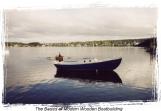2
For this storyline we asked Samuel Feltham from Glovertown to provide us with preliminary sketches and thoughts that come into his mind when he, a lifelong boatbuilder, thinks of building a boat.An important feature of these boats is the lack of any architectural drawings or plans other than their "moulds" (forehook, midship hook, afterhook). An admired boatbuilder, he would lend his 'moulds' to neighbours who would either try to imitate the original or try some alteration. Since the shape and other qualities of the boat would depend on where the "hooks" were placed, the outcome might be an improvement or something outlandish - depending on the skills of the builder. Some boat builders tested their hand-built models in little brooks and observed how they behaved when pulled through the water.
4
Here is his sketch #1. It shows a wooden boat twenty-two feet long and seven feet wide at midship. The sketch indicates the position of, and the shape of, the three major timber sets - that is, the three timber sets which are first attached to the keel to give the boat its basic shape and structure. These timber sets are called the forehook, the midship timber and the afterhook. Each is composed of two symmetrical timbers -- one for the port side, one for the starboard side. The sketch also shows the shape of the counter -- that is the stern end for the boat.6
In sketch #2 we find a bigger boat - thirty-two to thirty-four feet in length and eleven feet wide. The boat type here is the cruiser. She would be used for "cruising" - that is, searching, finding and bringing home products such as rocks, firewood, boat timber, kelp.8
In sketch # 3 we find a smaller wooden boat - eighteen feet long and four feet eight inches wide. She's a gunning boat used for birding and sealing. Note the slob hauler - a wooden device used to help manipulate the boat in slob, that is in ice too thin and dangerous to walk on and too thick to make ordinary rowing easy.Typical dimensions for such a boat would be:
18' - 19' in length
4' - 5' in width
20" - 22" in depth
Such little boats might be used for bringing mail, traveling to firewood source or fetching the midwife from a nearby populated island.
These little boats often were less rounded and more v-shaped than rodneys. They were also narrower so they could manipulate more easily through slob. They often carried three sets of paddles, one sculling oar, but rarely a sail.






